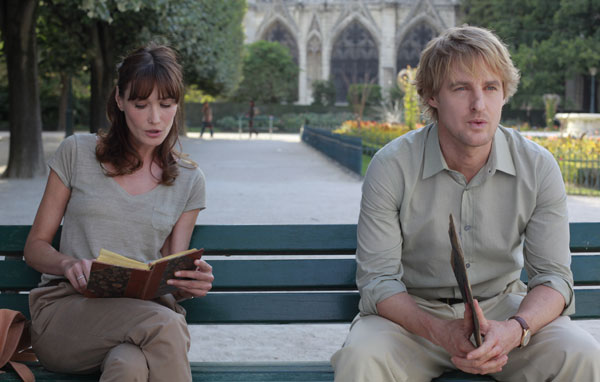Watch This: Midnight in Paris

Earlier this month, a publicist for the new Woody Allen movie, Midnight in Paris, asked if I wanted to come to an advance screening—she knows I don’t write much about movies on Beatrice, but, she hinted, there was something in the film I’d likely find very entertaining. I was game, so two weeks ago I dropped by a midtown screening room to see what was what. I’ll admit that it didn’t get off to an especially good start: The relationship between Owen Wilson’s Gil, a screenwriter struggling to reconnect with his literary ambitions, and Rachel MacAdams’s Inez, who doesn’t seem to do much besides have wealthy parents, is quite obviously doomed, what with her constantly undercutting his dreams privately and in front of her (decidedly not their) friends. I don’t mind stacking the narrative deck a bit, but there’s such a thing as overdetermination, after all.
Still, I figured the publicist was thinking about something bigger than “Gil’s a writer” when she invited me, and, sure enough, about a third of the way into the picture, Gil pauses on a Paris side street and finds himself in the era for which he’s most nostalgic, the “Movable Feast” of the 1920s. A lot of historical cameos ensue; none of them have any particular dramatic punch, but some of them are greatly entertaining; Corey Stoll, for example, does an excellent job of delivering Ernest Hemingway’s lines in a Hemingwayesque manner, and Adrien Brody is clearly having fun in his one scene as Salvador Dali. Of course, if there were nothing more to Gil’s trips back and forth in time than the “postcards from the Lost Generation” vibe, things would get boring fast, so it makes perfect dramatic sense that on his second night in the past, he should become infatuated with Picasso’s latest mistress, Adriana (played by Marion Cotillard).
Gil is able to express his authentic feelings and enthusiasms with Adriana (with all of ’20s Paris, really) without the fear of ridicule that comes with being around Inez and her family and friends, which serves to widen the crack in his engagement until it’s irrevocably severed. At the same time, by watching Adriana’s obsession with the Belle Epoque, he’s also able to recognize the shortcomings of his own nostalgia and, after the final reel, one assumes he’ll learn to readjust his priorities to making the most of the creative opportunities in his present surroundings—enjoying the cultural highlights of the past without getting caught up in them. (The fact that he’s met a French woman who’s ten years younger than Inez—so, no, that’s not the Carla Bruni cameo—but loves Cole Porter as much as he does presumably speeds that process along.) It’s not so much a romantic comedy as a breakup comedy that hints at a better romance, and as I mentioned earlier it can be a bit too obvious on that front, but the historical sequences are cleverly entertaining, and I wound up liking Midnight in Paris more than I thought I would.
photo: Sony Picture Classics
23 May 2011 | watch this |

 Our Endless and Proper Work is my new book with Belt Publishing about starting (and sticking to) a productive writing practice.
Our Endless and Proper Work is my new book with Belt Publishing about starting (and sticking to) a productive writing practice. 
